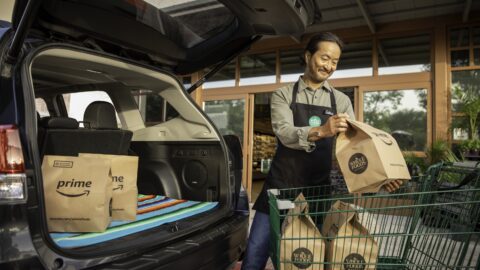Many retailers kicked off holiday promotions early to make up for a short buying season, but shopping won’t really kick into full gear until after Thanksgiving: one in three Americans are waiting until Black Friday to do the bulk of their holiday shopping, according to a study by Quantum Metric. While Black Friday doesn’t have the e-Commerce focus of Cyber Monday, retailers can still expect a 500% increase to their web site traffic.
Retailers saw a 16% jump in conversions on Black Friday last year, and pages that simply featured the word “sale” saw 10X the average day’s traffic — even if they made no direct connection to the surrounding holiday. Additionally, 22% of shoppers will know exactly what products they want to purchase on that day, and these prepared customers will represent 55% of Black Friday revenue. The opportunity for retailers is that these deal-hungry shoppers are primed to have their basket size expanded.
“I think getting a good understanding of what items pair well is important,” said Mario Ciabarra, CEO and Founder of Quantum Metric in an interview with Retail TouchPoints. “Take Walmart: one of the fun insights the company had was that diapers and beer sell well together, so it put diapers and beer together in its stores. Similarly, knowing which products sell well together online makes sense on Black Friday. Yes, shoppers are beelining for a single item, but if you’re already going through that checkout process and you see something else at the right price, you should be able to add that item with the click of a button.”
Shoppers With A Gift In Mind Still Use Search
Even shoppers who know exactly what they want aren’t necessarily skipping right to checkout: the average targeted shopper still navigates through 12 search pages before they make a purchase. These customers are 150% more likely to eventually make a Black Friday purchase than other shoppers, so retailers need to make sure their long journey is smooth to capture their valuable business.
Advertisement
Historical data is vital to paving this path to purchase. Retailers need to understand the way all shoppers navigate through their site throughout the year, then refine the process and smooth out any bumps to keep Black Friday shoppers in their own ecosystem — without any frustrations or temptations that could send potential conversions to competitors.
“If I look at my landing page, how do people interact with the elements on the page? What outcomes do they lead to?” Ciabarra said. “In the old days, we thought about heat maps and where people click most. I’m not super excited about that anymore. I’m interested in knowing where shoppers who interact with these parts of the site are more likely to buy, then doubling down on making those parts as accessible as possible. Taking a methodical approach and finding the biggest opportunity to have the biggest impact is the way to prepare for Black Friday and Cyber Monday.”
Address ‘Low-Hanging Fruit’ To Ensure A Smooth Journey
The sheer breadth of Black Friday deals mean shoppers can afford to be fickle — after all, there are plenty of good sales everywhere. As a result, Black Friday visit durations are 13% shorter than average, and cart abandonments rose 138% above the daily average, to 20%, in 2018. Shoppers shared some of their top reasons for abandoning a purchase journey on Black Friday:
- One in two say checkout errors delayed a purchase;
- One in two say their product selection was out of stock;
- One in three say the search function didn’t deliver their desired result; and
- One in three say long loading times impeded their navigation.
The occasional hiccup is unavoidable, so retailers need to focus on finding and fixing the “low-hanging fruit,” according to Ciabarra. Overall site performance is an area that’s easy to optimize and universally beneficial: shoppers who have to wait six seconds are 50% less likely to make a purchase, and 33% of shoppers will visit a competitor if the site they are on is slow to load.
Additionally, every retailer should make sure they are familiar with their own most common points of failure, with “finding the biggest opportunity to have the biggest impact” once again serving as the primary goal. Even if the problem can’t be solved by Black Friday, staying alert and having staff on standby to handle outages can minimize any unfortunate, and costly, downtime.
“If the site doesn’t work, I’m not going to sit there and call customer service. I’m just going to go find what I’m looking for somewhere else,” said Ciabarra. “Make sure you know where the choke points are, where the frustration points are and where the things aren’t always working. Have some way to monitor how things are going in real time — getting results back an hour later won’t cut it. An hour on Black Friday is critically important, and losing one means you’re going to miss out on a large opportunity.”
Many retailers kicked off holiday promotions early to make up for a short buying season, but shopping won’t really kick into full gear until after Thanksgiving: one in three Americans are waiting until Black Friday to do the bulk of their holiday shopping, according to a study by Quantum Metric. While Black Friday doesn’t have the e-Commerce focus of Cyber Monday, retailers can still expect a 500% increase to their web site traffic.
Retailers saw a 16% jump in conversions on Black Friday last year, and pages that simply featured the word “sale” saw 10X the average day’s traffic — even if they made no direct connection to the surrounding holiday. Additionally, 22% of shoppers will know exactly what products they want to purchase on that day, and these prepared customers will represent 55% of Black Friday revenue. The opportunity for retailers is that these deal-hungry shoppers are primed to have their basket size expanded.
“I think getting a good understanding of what items pair well is important,” said Mario Ciabarra, CEO and Founder of Quantum Metric in an interview with Retail TouchPoints. “Take Walmart: one of the fun insights the company had was that diapers and beer sell well together, so it put diapers and beer together in its stores. Similarly, knowing which products sell well together online makes sense on Black Friday. Yes, shoppers are beelining for a single item, but if you’re already going through that checkout process and you see something else at the right price, you should be able to add that item with the click of a button.”
Shoppers With A Gift In Mind Still Use Search
Even shoppers who know exactly what they want aren’t necessarily skipping right to checkout: the average targeted shopper still navigates through 12 search pages before they make a purchase. These customers are 150% more likely to eventually make a Black Friday purchase than other shoppers, so retailers need to make sure their long journey is smooth to capture their valuable business.
Historical data is vital to paving this path to purchase. Retailers need to understand the way all shoppers navigate through their site throughout the year, then refine the process and smooth out any bumps to keep Black Friday shoppers in their own ecosystem — without any frustrations or temptations that could send potential conversions to competitors.
“If I look at my landing page, how do people interact with the elements on the page? What outcomes do they lead to?” Ciabarra said. “In the old days, we thought about heat maps and where people click most. I’m not super excited about that anymore. I’m interested in knowing where shoppers who interact with these parts of the site are more likely to buy, then doubling down on making those parts as accessible as possible. Taking a methodical approach and finding the biggest opportunity to have the biggest impact is the way to prepare for Black Friday and Cyber Monday.”
Address ‘Low-Hanging Fruit’ To Ensure A Smooth Journey
The sheer breadth of Black Friday deals mean shoppers can afford to be fickle — after all, there are plenty of good sales everywhere. As a result, Black Friday visit durations are 13% shorter than average, and cart abandonments rose 138% above the daily average, to 20%, in 2018. Shoppers shared some of their top reasons for abandoning a purchase journey on Black Friday:
· One in two say checkout errors delayed a purchase;
· One in two say their product selection was out of stock;
· One in three say the search function didn’t deliver their desired result; and
· One in three say long loading times impeded their navigation.
The occasional hiccup is unavoidable, so retailers need to focus on finding and fixing the “low-hanging fruit,” according to Ciabarra. Overall site performance is an area that’s easy to optimize and universally beneficial: shoppers who have to wait six seconds are 50% less likely to make a purchase, and 33% of shoppers will visit a competitor if the site they are on is slow to load.
Additionally, every retailer should make sure they are familiar with their own most common points of failure, with “finding the biggest opportunity to have the biggest impact” once again serving as the primary goal. Even if the problem can’t be solved by Black Friday, staying alert and having staff on standby to handle outages can minimize any unfortunate, and costly, downtime.
“If the site doesn’t work, I’m not going to sit there and call customer service. I’m just going to go find what I’m looking for somewhere else,” said Ciabarra. “Make sure you know where the choke points are, where the frustration points are and where the things aren’t always working. Have some way to monitor how things are going in real time — getting results back an hour later won’t cut it. An hour on Black Friday is critically important, and losing one means you’re going to miss out on a large opportunity.”









